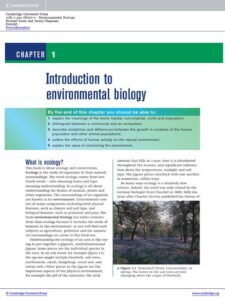Back to: Environmental Biology 100 Level
Welcome to class!
Hello brilliant scholar! How are you feeling today? I’m so glad you’re here because we’re about to start something exciting together. Today’s topic is one that affects your life every single day, even when you’re not thinking about it. Ready? Let’s go!
Introduction To Environmental Biology
What is Environmental Biology?

Imagine waking up one morning and there is no clean water to drink, no fresh air to breathe, and no trees to give shade. Life would be almost impossible, right? Environmental Biology is the study of how living things (like humans, plants, and animals) interact with their environment. The environment includes everything around us—air, water, soil, light, and even other living things.
Why is it Important?
Let’s think about Nigeria for a moment. Remember how Lagos often faces flooding during heavy rains? Or how some northern states experience desert-like conditions? These are environmental issues that affect people’s lives. Environmental Biology helps us understand these problems and find solutions that make life better for everyone.
The Two Main Parts of Environment
The environment has two main parts:
1. Biotic components – These are the living things like plants, animals, and humans. For example, a mango tree in your compound or goats grazing in a village farm are all biotic components.

2. Abiotic components – These are the non-living things like soil, water, air, sunlight, and temperature. Without these, life cannot exist. For instance, farmers in Benue need good soil and water to grow yams.
Relationship Between Living Things and Environment
Have you ever noticed how birds build nests on trees or how fish live in water? This shows how living things depend on their environment to survive. Humans also depend on the environment for food, water, energy, and shelter. At the same time, we affect the environment through activities like farming, building, and even driving cars.

Think of Abuja city. As the population grows, more houses and roads are built. Trees are cut down, and this affects the animals that live there. This is why understanding Environmental Biology is so important—so we can live in a way that does not destroy nature.
Summary
Environmental Biology studies the relationship between living things and their environment. The environment has biotic (living) and abiotic (non-living) parts, and both are connected.
Evaluation
1. What is Environmental Biology?
2. Mention two biotic and two abiotic components of the environment.
3. Give one example of how humans depend on the environment.
You’re doing amazing! Always remember, you are the future of Africa, and learning this is a big step towards making our world better. See you in the next lesson with Afrilearn—where learning is fun and personal!
